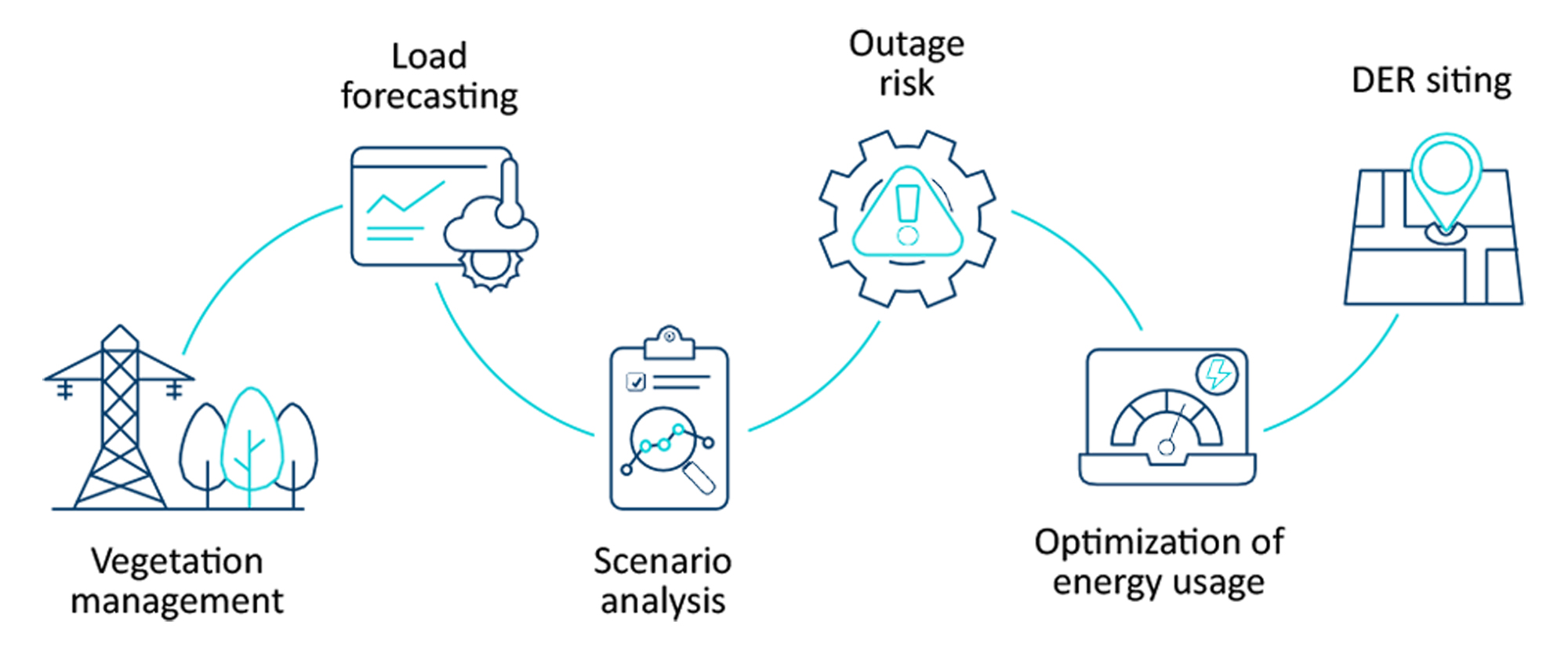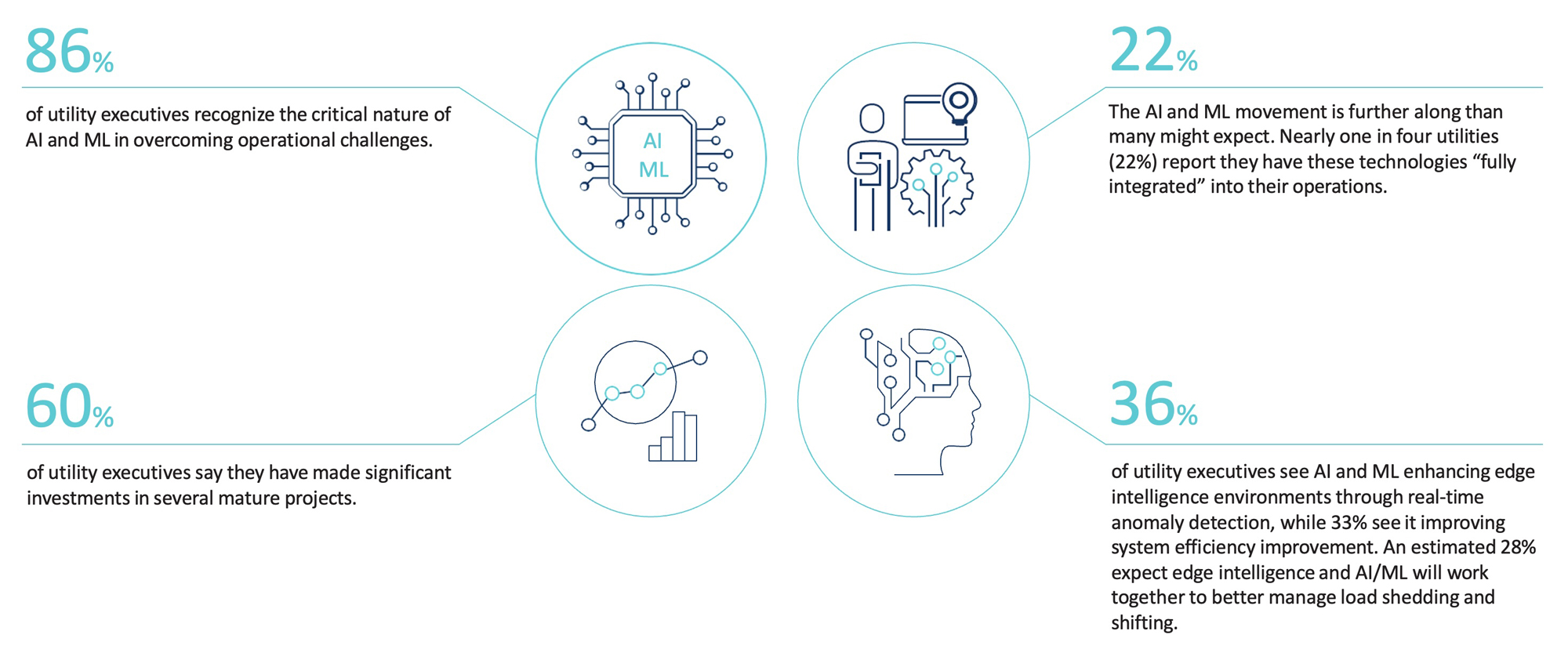How AI Can Drive Business Transformation – For Utilities and Energy Companies
-
October 23, 2025
DownloadsDownload Article
-
Utility and energy supply companies are undergoing rapid and profound changes driven by shifts in regulatory priorities, increasing supply chain costs, evolving customer expectations, sustainability goals and emerging technologies. Traditional utility business models that once relied on predictable demand and centralized infrastructure are no longer viable. Recent growth of distributed energy resources (“DER”), smart grids and expanded energy choice programs, as well as electrification trends and increased pressure to decarbonize operations, have only increased operational complexity.
To navigate this new paradigm, industry leaders must embrace transformative strategies that enable greater agility, efficiency and innovation while remaining focused on engaging and educating their customers through this change. Artificial Intelligence (“AI”) can be a key enabler of this transformation, providing powerful capabilities to enhance strategic decision-making, streamline processes, optimize staffing models, drive cost efficiencies, and, critically, improve the customer experience. This article explores how leveraging traditional business transformation approaches with AI can drive next level results.
AI-Powered Strategy Development
An evolving industry landscape coupled with increased customer needs requires forward-thinking, data-driven decision-making to stay ahead. AI-driven analytics can support strategic planning by managing vegetation near distribution infrastructure, forecasting future load on the system, identifying outage risks and simulating different capital expenditures and market scenarios.
Machine learning (“ML”) algorithms can analyze historical data such as energy usage and demand alongside external variables such as weather patterns, regulatory changes and economic indicators to provide predictive insights that inform investment decisions, maintenance and inspection programs, rate and pricing structures and strategic infrastructure development.
According to a 2024 survey from technology company Itron, a majority of global utilities recognize the importance of AI and ML and have made investments in pilots or projects; however, under a quarter of surveyed utilities have reached full implementation potential.1
AI also enhances scenario planning by simulating the impact of different strategic choices. For example, utilities can use AI to assess the financial and operational implications of expanding renewable energy penetration, implementing demand response programs, storm response scenarios or entering new service markets. By leveraging AI-driven modeling and decision support tools, utilities can craft more resilient and adaptive strategies that align with both regulatory expectations and market opportunities. Similarly, energy supply companies can simulate competitive pricing structures, forecast demand scenarios to support advanced revenue modeling and automate processes to reduce friction in the customer experience.
Innovative AI Solutions
- Utilities such as Avista, PG&E and Ameren have demonstrated AI’s potential in tasks ranging from nuclear plant design to electric vehicle charging optimization.3
- AiDash has developed a solution that can use satellite imagery and AI to help utilities approach vegetation management more strategically to reduce costs and improve reliability.4
- Similarly, Neara offers a 3D platform that can assist with understanding outage risks during high winds.5
Process Realignment and Improvement Through AI
Operational inefficiencies have long been a challenge for utilities, leading to unnecessary costs and service disruptions. AI-driven process automation and optimization can enhance efficiency in areas such as customer service, asset management, grid operations and back-office functions.
Predictive maintenance powered by AI can allow utilities to anticipate equipment failures before they occur, reducing downtime and maintenance costs. AI models accomplish this by analyzing real-time sensor data from grid infrastructure, power plants and transmission lines to detect anomalies which enable proactive interventions. Similarly, AI-powered grid management systems can optimize energy distribution by dynamically adjusting loads through expanded demand response programs and utilizing renewable sources more effectively.
Beyond operations, AI-driven process automation can streamline administrative functions such as billing, regulatory reporting and workforce scheduling. By eliminating bottlenecks and reducing manual effort, AI enhances both speed and accuracy, allowing utilities to allocate resources more strategically.
AI also offers opportunities to improve the customer experience, especially for companies with fragmented systems, lack of clear processes and inconsistent data formats. These issues can result in lower customer satisfaction scores, abandoned customer sign-up and loss of valued customers. AI can help unify and standardize the onboarding experience by automatically consolidating customer information across different databases, identifying and resolving duplicates and validating inputs in real time. Natural language processing tools can streamline customer interactions by guiding users through the registration process with intuitive, conversational interfaces, reducing the need for manual customer service intervention. By making their customer sign-up process seamless, faster and more reliable, energy suppliers, for example, can improve first impressions, reduce churn and build lasting customer loyalty.
Case Study: Blending the Capabilities of Traditional Business Transformation With AI
FTI Consulting (“FTI”) recently led a successful process improvement initiative for a major energy supplier grappling with customer sales, onboarding and after-sales inefficiencies following a series of mergers and acquisitions (“M&A”) that combined geographically dispersed companies. The company faced challenges due to redundant platforms, inconsistent customer data, lack of process documentation and consistency, and varying onboarding workflows across its newly combined service territories.
FTI Consulting deployed a multi-disciplinary team to assess the existing sales processes, organizational design and technology stack to identify opportunities to unify processes and leverage AI and automation. By utilizing a combination of traditional process management and AI approaches to harmonize process, people and tools, FTI Consulting helped the client reimagine an organizational design that centralized sales and consolidated its technology stack from multiple legacy systems while embedding AI solutions through a customized road map.
The result was a refocused sales organization where enabling functions were realigned to improve sales intelligence, which accelerated prospecting activities, streamlined the sign-up and on-boarding process, and drove down after-sales errors, among other improvements.
This case illustrates how a well-structured AI-enabled transformation, guided by experienced experts, can quickly unlock value in post-M&A environments where customer experience is at risk.
AI Customer Service Stats
- Entergy implemented AI and at the same time experienced a 10 percent increase of its American Customer Satisfaction Index.6
- Sales through Verizon’s Customer Service Team were up 40 percent since deploying AI features that assists its customer service representatives.7
- Vodafone reported that calls to customer service dropped by 20 percent when it began the use of generative AI, and customer service has improved by 50 percent.8
Reorganization and Workforce Optimization
As companies modernize, their workforce structures must evolve to align with new business models, technologies and customer demands. AI-driven workforce analytics can support reorganization efforts by identifying skill gaps, predicting future talent needs and optimizing team structures for maximum efficiency.
For example, AI-powered talent management platforms can analyze workforce data to determine optimal staffing levels, assess employee performance and recommend training programs tailored to emerging industry needs. Additionally, AI can improve workforce planning by forecasting demand for specialized roles, such as data scientists and grid modernization experts, ensuring that companies have the right talent in place to support both short- and long-term transformation initiatives.
Moreover, AI-driven digital assistants and intelligent automation tools enable companies to augment human capabilities, rather than simply reducing headcount, which also enhances employee buy-in and engagement. By offloading repetitive and administrative tasks, AI allows employees to focus on higher-value activities, fostering a more innovative and strategic workforce.
Cost Takeout and Financial Efficiency
Cost pressures in the utility sector are intensifying due to evolving regulatory requirements, increased reliability demands and additional operational complexities. AI presents multiple opportunities to drive cost savings while also improving service reliability and quality.
One emerging trend is to use AI to support cost takeout through operational efficiencies. This includes AI-driven process automation that cuts administrative costs by reducing paperwork, improving workflow efficiency and minimizing human error.
AI can also enhance fraud detection and revenue protection by analyzing billing patterns and identifying anomalies that may indicate theft, non-payment risks or billing inaccuracies. By leveraging AI-powered insights, companies can recover lost revenue while maintaining strong customer relationships.
Case Spotlight: GridWise – AI-Driven Load Forecasting for Smarter Utility Operations
Utilities face increasingly dynamic and challenging grid conditions driven by electrification, climate volatility, policy shifts, and distributed resources. Traditional forecasting models struggle to adapt, leading to higher costs, poor investment decisions, and reliability risks.
FTI Consulting developed GridWise, an AI-powered forecasting platform that integrates grid performance data, historical load profiles, weather, and market signals to deliver highly accurate, adaptive forecasts. Unlike static models, GridWise continuously learns from new data, maintaining precision even under rapidly changing conditions. Early versions achieved less than 6% Mean Absolute Percentage Error (“MAPE”), rivaling or surpassing industry benchmarks, with accuracy improving as localized inputs are added.
Beyond accuracy, GridWise supports scenario-based analysis, enabling utilities to model the effects of EV adoption, extreme weather or policy changes on load patterns. This helps planners allocate resources, prioritize upgrades, and balance decarbonization mandates with affordability and reliability. Utilities can begin with a pilot to test GridWise performance under their own system conditions. These pilots require limited upfront resources and provide a practical way to evaluate improvements in forecasting accuracy. Results from initial pilots can then be scaled across the organization, supporting long-term planning and operational reliability.
Conclusion
AI has the potential to rapidly transform the utility and energy sectors and can enable leaders to develop more effective strategies, streamline operations, optimize workforce structures and achieve significant cost efficiencies. By leveraging AI-driven analytics, automation and optimization capabilities, utilities can enhance decision-making, improve service reliability and accelerate their transition toward a more sustainable and agile business model. However, to maximize the benefits of AI, utility leaders must foster a culture of digital innovation, invest in AI-driven infrastructure and ensure that their workforce is equipped and engaged to leverage these advanced technologies effectively.
AI Case Studies
FTI Consulting has helped our utility and energy sector partners harness the power of AI to drive measurable improvements across operations, customer experience and regulatory compliance.
Whether you’re optimizing asset performance, automating manual processes or enhancing decision-making through predictive analytics, our experts bring deep industry knowledge and proven transformation frameworks to deliver real results.
You Can Partner With Us To:
- Identify high-impact AI use cases tailored to your utility’s needs;
- Streamline workflows and reduce operational costs;
- Improve reliability, safety and customer satisfaction; and
- Navigate data governance, cybersecurity and regulatory considerations with confidence.
Don’t just adopt AI — transform with purpose.
Footnotes:
1: “Itron Resourcefulness Report: Exploring AI for Utilities: The Promises and Challenges of Artificial Intelligence,” Itron North America (October 7, 2024).
2: Ibid.
3: Herman K. Trabish, “Avista, PG&E, Ameren AI demonstrations show great potential – but are other utilities ready?” Utility Dive (March 7, 2025).
4: Luis Garcia, “Lightsmith Group Backs AI Startup AiDash With Eye on Power-Grid Expansion,” WSJ Pro Private Equity (April 29, 2024).
5: Varsha Bansal, “TIME100 Most influential Companies 2024, Neara Grid intelligence,” Time (May 30, 2024).
6: Press Release, “Salt River Project Makes Powerful Statement, as Satisfaction With Energy Utilities Dips Overall, ACSI® Data Show,” American Customer Satisfaction Index (March 25, 2025).
7: Kenrick Cai, “Verizon says Google AI for customer service agents has led to sales jump,” Reuters (April 9, 2025).
8: Tom Saunders, “AI Will Have an ‘Extremely Positive’ Effect on Teaching,” The Times (June 20, 2024).
Published
October 23, 2025
 Key Contacts
Key Contacts
Global Practice Leader Power, Renewables & Energy Transition (PRET)
Director





